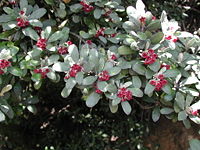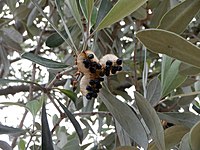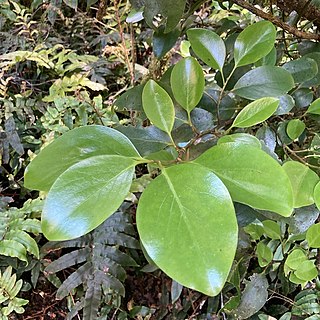
Griselinia littoralis, commonly known as kapuka, New Zealand broadleaf or pāpāuma, is a fast-growing small to medium-sized evergreen tree that is native to New Zealand.

Alectryon excelsus, commonly known as tītoki, or sometimes New Zealand oak, is a shiny-leaved tree native to New Zealand. It is in the family Sapindaceae. It lives in coastal and lowland forests throughout most of the North Island and from Banks Peninsula to central Westland in the South Island.

Coprosma robusta, commonly known as karamū, is a flowering plant in the family Rubiaceae that is endemic to New Zealand. It can survive in many climates, but is most commonly found in coastal areas, lowland forests, or shrublands. Karamū can grow to be around 6 meters tall, and grow leaves up to 12 centimeters long. Karamū is used for a variety of purposes in human culture. The fruit that karamū produces can be eaten, and the shoots of karamū are sometimes used for medical purposes.

Myoporum is a genus of flowering plants in the figwort family, Scrophulariaceae. There are 30 species in the genus, eighteen of which are endemic to Australia although others are endemic to Pacific Islands, including New Zealand, and one is endemic to two Indian Ocean islands. They are shrubs or small trees with leaves that are arranged alternately and have white, occasionally pink flowers and a fruit that is a drupe.

Urtica ferox, commonly known as tree nettle and in Māori: ongaonga, taraonga, taraongaonga, оr okaoka, is a species of nettle endemic to New Zealand. Unlike the other species in the genus Urtica found in New Zealand, all of which are herbaceous, ongaonga is a large woody shrub that can grow to a height of 3 m (9.8 ft), with the base of the stem reaching 12 cm (4.7 in) in thickness. It has large spines that can result in a painful sting that lasts several days.

Pittosporum is a genus of about 200 species of flowering plants in the family Pittosporaceae. The genus is probably Gondwanan in origin; its present range extends from Australasia, Oceania, eastern Asia and some parts of Africa. Citriobatus can be included here, but might be a distinct genus. They are commonly known as pittosporums or, more ambiguously, cheesewoods.
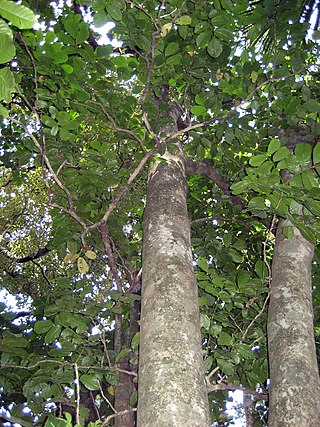
Kohekohe is a medium-sized tree in the Meliaceae family, native to New Zealand. It is found in lowland and coastal forests throughout most of the North Island and also occurs in the Marlborough Sounds in the north of the South Island. Mature trees grow up to 15 metres (49 ft) in height, with a trunk up to a metre in diameter.
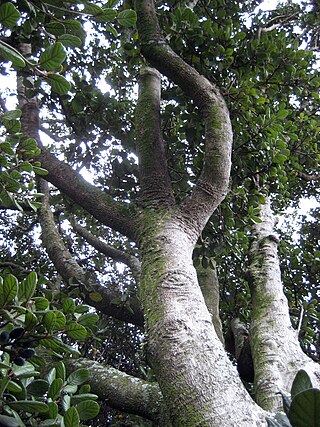
Beilschmiedia tarairi, commonly called taraire, is a tree of the family Lauraceae, endemic to the North Island of New Zealand. It is a common canopy tree in lowland forests north of Auckland, often growing in association with kauri, pōhutukawa, tawāpou, and pūriri on basalt rocks and soils. Beilschmiedia is a genus of about 40 mainly tropical trees and shrubs with alternate to opposite leaves.

Pittosporum tenuifolium is a small evergreen tree endemic to New Zealand – up to 10 m (33 ft) – commonly known as kōhūhū and black matipo, and by other Māori names kohukohu and tawhiwhi. Its small, very dark, reddish-purple flowers generally go unnoticed, and are scented only at night. The Latin tenuifolium means "slender-leaved"
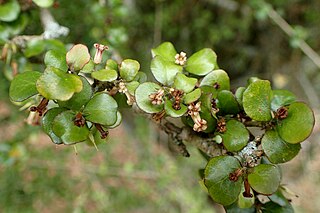
Pittosporum obcordatum, commonly called heart-leaved kohuhu or heart-leaved kohukohu or kohukohu, is a species of plant in the Pittosporaceae family. It is endemic to New Zealand, and exists both in North Island and South Island.

Pittosporum eugenioides, common names lemonwood or tarata, is a species of New Zealand native evergreen tree. Growing to 12 m (39 ft) tall by 5 m (16 ft) broad, it is conical when young but more rounded in shape when mature. Its leaves are mottled yellow-green with curly edges and a salient bright midrib, and have a strong lemony smell when crushed. It has highly fragrant clusters of attractive yellow-cream flowers in spring, followed by distinctive black seed capsules. It is found throughout New Zealand's North and South Islands along forest margins and stream banks from sea level to 600 m (1,969 ft). It is New Zealand's largest Pittosporum.

Pittosporum bicolor, commonly known as cheesewood or banyalla, is a flowering shrub or small tree of the family Pittosporaceae, and is native to south eastern Australia.

Olearia paniculata, commonly called akiraho, is a species of shrub or tree in the family Asteraceae, found only in New Zealand. The tree can grow to 6 metres high, and has yellow-green, oval-shaped leaves, with white undersides and wavy margins.
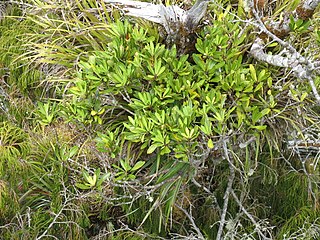
Pittosporum kirkii is a glabrous evergreen perennial shrub that reaches up to 5 metres (16 ft) in height and possesses distinctive coriaceous, fleshy, thick leaves. It is one of four shrubs endemic to New Zealand that frequently displays an epiphytic lifestyle. P. kirkii is commonly epiphytic, perched amongst nest epiphytes in the canopies of emergent or canopy trees in old-growth forest; however, it can be observed occasionally growing on the ground or over rocks. Kirk first observed P. kirkii on Great Barrier Island. It was described by Joseph Dalton Hooker from material collected by Thomas Kirk, possibly from the Thames Goldfields, and published in 1869. The initial brief description titled Pittosporum n. sp.? by Thomas Kirk was published in his paper on Great Barrier Island in 1868. This description along with herbarium specimens were sent to Dr. J. D Hooker at Kew Gardens in 1868, and he collaborated to name it after T. Kirk, by giving it the specific epithet kirkii within the publication that was otherwise written by Kirk.

Fuchsia procumbens is a prostrate shrub that is endemic to coastal areas of the North Island of New Zealand. Common names include creeping fuchsia, climbing fuchsia or trailing fuchsia.

Pittosporum cornifolium, known as tāwhiri karo in Māori, is a species of plant in the Pittosporaceae family. It is an epiphytic plant endemic to the North Island and the Marlborough Sounds of the South Island, New Zealand. In the wild it is considered rare and threatened, although it occurs more frequently on offshore islands in the north-east, along with P. kirkii, the only other epiphytic member of the genus. Also grows well as a ground plant and is a popular garden ornamental with two recognised cultivars.

Jovellana sinclairii, commonly known as the New Zealand calceolaria, is an endemic New Zealand shrub found in eastern and central North Island forests. In the family Calceolariaceae, it has white, bell shaped flowers with spots of purple on the inside.

Pittosporum ferrugineum, commonly known as the rusty pittosporum or rusty-leaved pittosporum, is an evergreen plant in the family Pittosporaceae native to Malesia, Papuasia, the Northern Territory and Queensland.
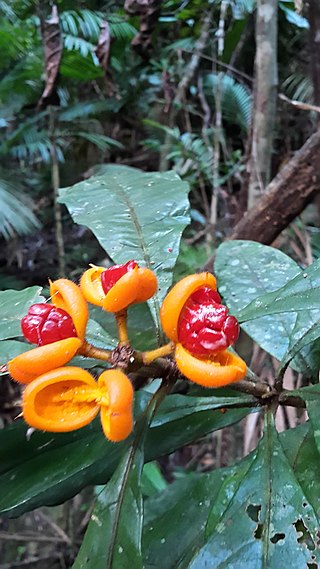
Pittosporum rubiginosum, commonly known as hairy red pittosporum, is an evergreen shrub in the family Pittosporaceae which is endemic to northeastern Queensland, Australia. It was first described in 1840.



